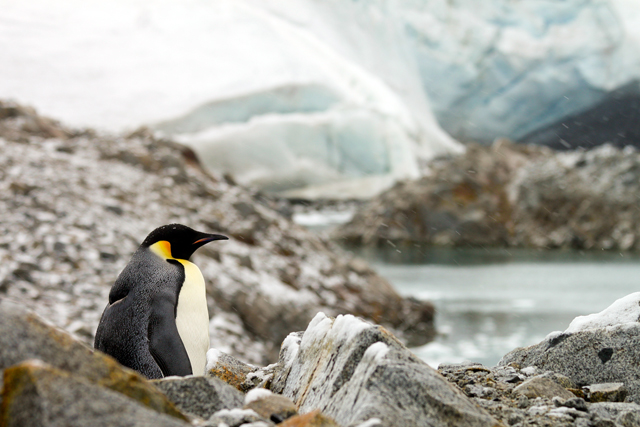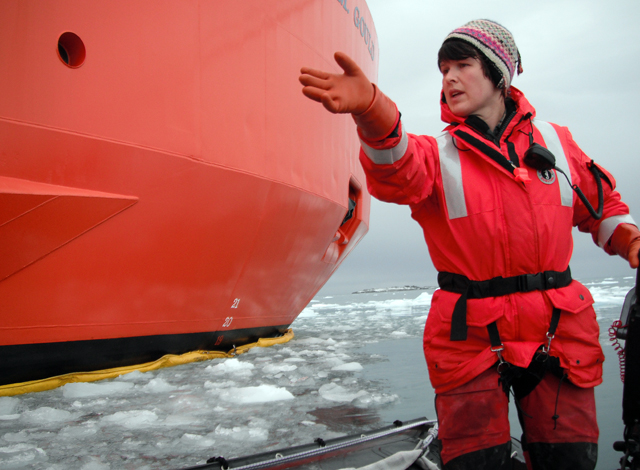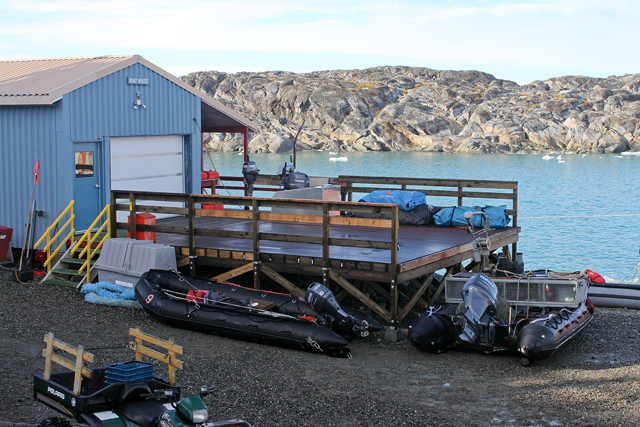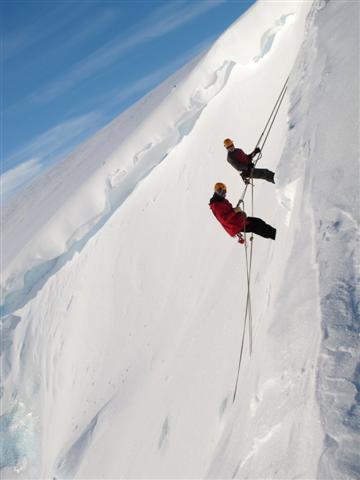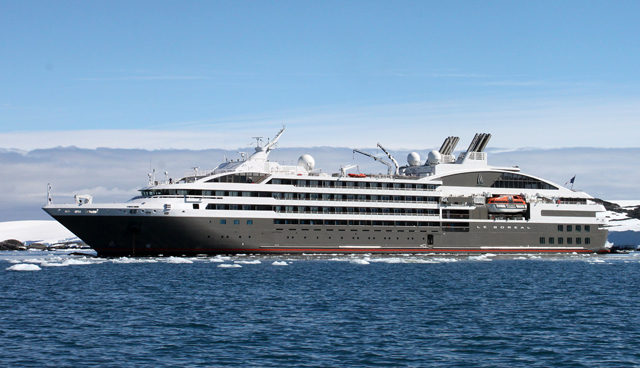|
Palmer Station Archives - 2011 Sea ice continues to stymie researchers at Palmer StationPosted December 9, 2011
Sea ice along the southern Antarctic Peninsula continues to be problematic to science efforts at Palmer Station A wide band of ice beginning at the southern end of Anvers Island extends all the way down to the Bellingshausen Sea. Because Palmer Station is on the northern tip of the band, wind and current conditions have strongly governed the state of sea ice around station. Pack ice has varied in density throughout the month of November, often too thick for boating operations. Northeasterly winds seem to offer the only reprieve. 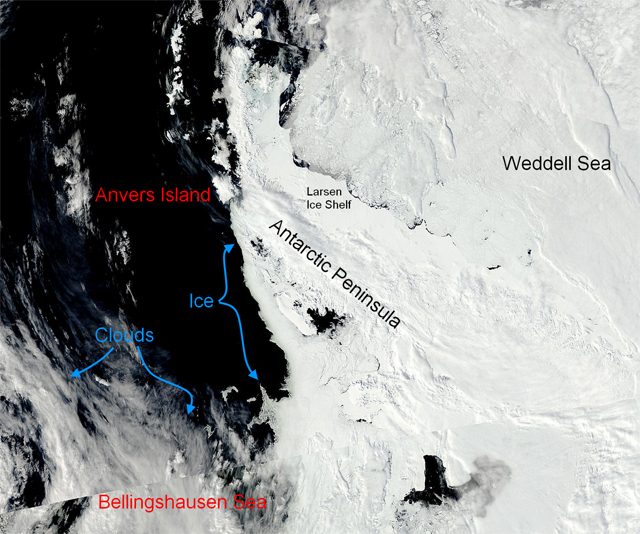
Photo Credit: NASA, with annotations by Brian Nelson
NASA MODIS satellite image of Palmer Station region on Nov. 14 shows ice-choked areas.
The Palmer Long Term Ecological Research (LTER) The Palmer Station research associate began collecting GPS ground control points for the Polar Geospatial Center (PGC) Temperatures are rising along the peninsula as we enter the austral summer, and much of the winter snow accumulation is now gone. The penguins have laid eggs, and other local birds are nesting. A week-long break in the wind in mid-November provided excellent conditions to get out and see the wildlife, as well as collect scientific data, before the relentless sea ice crept back into the area, seemingly of its own accord. 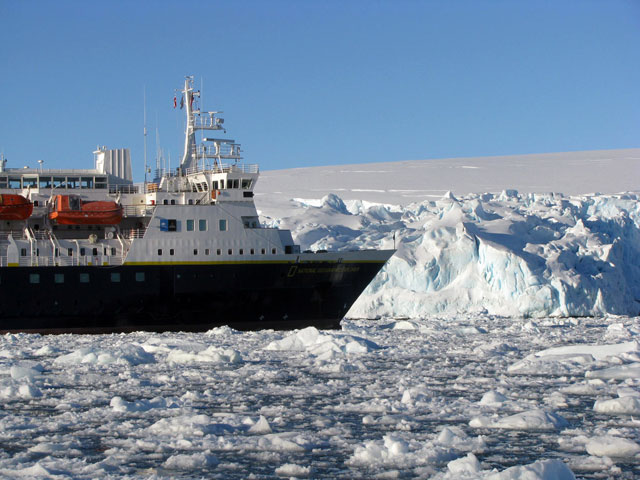
Photo Credit: Marci Levine
The National Geographic Explorer pushes through ice in Arthur Harbor near Palmer Station.
The ice didn’t stop the National Geographic Explorer from being the first tourist cruise ship to visit station this season. On Thanksgiving Day, more than 100 passengers were given a tour of station while Explorer Zodiac drivers steered ever-widening circles in Arthur Harbor to maintain a broken but reasonable path of open water back to the ship. The yacht Spirit of Sydney visited shortly after, carrying Jørgen Amundsen, a descendant of Roald Amundsen. As part of the centennial celebration of Roald Amundsen’s arrival at the South Pole on Dec. 14, 1911, Jørgen Amundsen will make an attempt to summit an unclimbed and unnamed peak along the Antarctic Peninsula on the same day. Jørgen Amundsen said he considered visiting the South Pole on this historic date, but felt that the spirit of adventure, discovery and accomplishment would be better memorialized by breaking new ground, rather than revisiting a location that is now well-established and much more easily attainable. Summer ice packs in Palmer Station to extent not seen in a decadePosted November 11, 2011
Palmer Station For the first time in 10 years, summer residents witnessed fast ice — sea ice fixed to the shore — with enough stability for foot travel. In fact, it’s been more than a few years since winter personnel have seen this occur. During September and the first half of October, scientists walked out to one of their sampling sites and dropped nets through a hole in the ice cut by chainsaw to collect phytoplankton for a project studying how the single-celled plants evolve through the seasons. [See related article — Turned on and off: Scientists study seasonal gene expression in phytoplankton.] In mid-October, the ice finally destabilized and blew out with a storm. Since then, Palmer has alternated between periods of strong northerly winds, precluding boating, and thick pack ice from horizon to horizon, also precluding boating. So, in lieu of field-station sampling, Palmer scientists have had to find creative ways to fill their sample bottles. The microbial arm of LTER has been using seawater that pumps through the aquarium. The zoological team has dropped nets over the side of the pier. The phytoplankton component of LTER brought four autonomous underwater vehicles with them this year, and they have one more on the way. One of these gliders is scheduled to “fly” all the way from Palmer to the British Antarctic Survey’s Rothera Station Last year, a glider made part of this trip and was retrieved by the research vessel Laurence M. Gould The LMG pushed her way through the pack ice this month for a multi-tasked cruise. Before reaching Palmer Station, she stopped at King George Island to open a field camp and at Duthiers Point, the entrance to Andvord Bay, to perform repairs to a GPS station. Once at Palmer Station, the LMG began loading tanks of waxy fuel to be transported to Punta Arenas for storage. Sea ice clears out as summer season gets under wayPosted October 7, 2011
The sea ice, which surrounded Palmer Station Although the sea ice was no longer visible from station, there was enough of it surrounding the peninsula to delay the arrival of the research vessel Laurence M. Gould 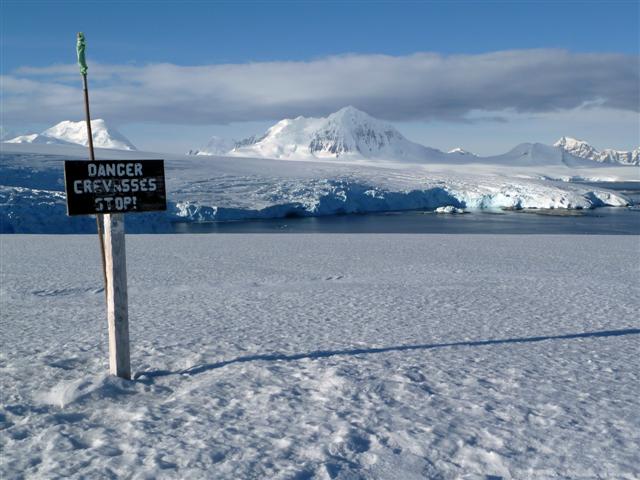
Photo Credit: Mindy Piuk/Antarctic Photo Library
A sign warns of crevasse danger at the top of the glacier that sits behind Palmer Station.
Winter and summer crewmembers worked together to offload fresh and frozen food. Several projects were planned for the port call, including the semiannual station refuel. Transferring fuel to Palmer Station from the ship is a station-wide project with many personnel involved in setting up, monitoring, and taking down the needed equipment. Many of the incoming summer personnel are returning crewmembers, picking up where they left off in March. Station positions and emergency teams turned over duties from the winter to the summer crew as well. The Gould left in late September, taking away half of the winter crew and leaving behind 35 station members, either completing their winter season, continuing their research, or beginning their 2011-12 summer at Palmer Station. First researchers of 2011-12 season arrive at Palmer StationPosted September 9, 2011
Winter was cut short early at Palmer Station The arrival of the ship brought the station’s population up to 25 from 15. A science group led by Deneb Karentz 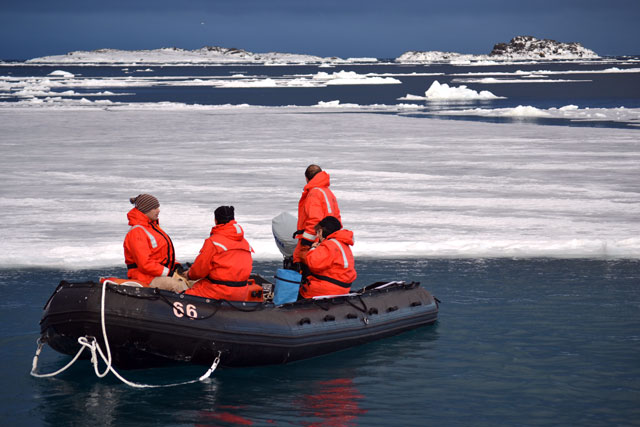
Photo Credit: Bethany Goodrich
Sea ice around Palmer Station throughout August made it difficult to leave the vicinity in a rubber Zodiac.
While the team has faced some challenges and limitations due to the presence of sea ice, the researchers have developed interesting and unique solutions to the problems. Palmer has been locked in sea ice almost the entire month, except for one very windy day that briefly pushed the ice out. A single Zodiac was able to get in the water for a few hours before being forced back to station, as the ice solidified once again. While the ice appears thick, littered with bergy bits, or chunks of glacier ice, it is not stable enough to be traveled over by foot. The ice may be a hindrance to both science and recreation, but it has provided some fantastic photographic opportunities. Recreation has been limited to land-based activities throughout the month, but that has not slowed most people down. Several storms deposited enough snow on the glacier to allow skiing and snowboarding, and some station residents took advantage of the rare opportunity for fresh powder in Antarctica. Most activities last month were based indoors, with movie nights, card games and hobby projects galore. 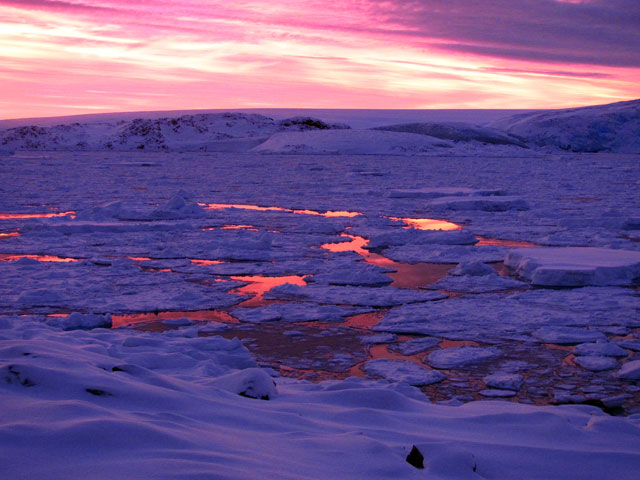
Photo Credit: Perri Barbour
The pink colors of twilight reflect on the snow and water near Palmer Station.
With the return of the Gould with part of the summer crew, winter at Palmer is coming to an end. Guidebooks are appearing on tables around station, and personnel surf the Internet during off-hours to search for exotic locales for upcoming vacations. Most residents are ready to undertake a new adventure, but there is still a feeling of fondness for this small, comfortable community. Many residents will return again next year, while for others it may be their last season on the Ice. Many friendships will be long distance for years to come, and some will begin to fade. Winter at Palmer is a unique experience, and the memories will last forever. As new community members come in, and others begin to leave, many activities on station will remain the same. Research will continue, as will normal station operations. Names and faces may rotate, but station requirements and challenges will never falter. As the weather begins to warm, new challenges and adventures await. Brief winter isolation at Palmer ends with arrival of new science teamsPosted August 12, 2011
There’s something about the darkness of mid-winter that inspires a celebration. Millennia ago, in Europe, the ancients celebrated the winter solstice by bringing evergreen branches into their homes as reminders of the lively verdancy of summer, and they feasted. By the latter days of the Roman Empire, this annual festivity evolved into Christmas. When Capt. Roald Amundsen and Capt. Robert Scott wintered at the edge of the Ross Ice Shelf On June 21, 2011, the sun did not appear over most of Antarctica. But it did shine over Anvers Island for less than four hours, the shortest day of the year. The temperature at Palmer Station That evening we sat down to a splendid dinner reminiscent of the first mid-winter celebrations 100 years earlier, as described in the memoirs of the Scott and Amundsen expeditions. This connection with the great explorers — and the upcoming centennial of their attainment of the South Pole — infused the event with the aura of a solemn occasion. And like Antarctica’s first inhabitants, we are spending these dark but cheerful days preparing for activities to come when winter departs. Various systems in the station’s infrastructure are undergoing repair or improvement, including the generator exhaust stacks, some of the electrical wiring, the galley ceiling and the Zodiac pontoons and their instrument and equipment boxes. The laboratories and aquarium are being prepared for the return of the scientists, the first of whom arrive with the research vessel Laurence M. Gould Palmer Station settles into winter multitaskingPosted July 15, 2011
June started with a flurry of activity, as the science groups packed up to leave, beginning with several entertaining events for the crews of Palmer Station A fun and oddly educational fish print party was held for cataloging icefish caught by one of our science parties for research, with homemade ice cream served as well. The farewell festivities concluded with an open mic night in the station lounge, and the audience was treated to musical performances by scientists, station personnel and Gould crewmembers. The last few remaining summer personnel were coaxed onto the Gould, leaving behind 15 of us to keep the station operating over the winter. This is the first time since September 2009 that Palmer Station has been without an active science group on station; however, data collection continues year-round for other projects. The winter staff celebrated the first day of isolation with a sushi dinner. Two weeks later, we were treated to an elegant Midwinter celebration dinner. Our chef prepared an exceptional meal including dishes such as bacon-wrapped scallops, roast pumpkin soup, Beef Wellington, crab legs, pumpkin ravioli and Baked Alaska for dessert. Notable differences started to occur for the winter personnel in June. Sea ice moved into the harbor, and wildlife sightings were rare. The weather became more overcast, making our short days seem even briefer. The overcast weather has made us appreciate the rare clear conditions even more, with cameras ready for any spectacular dawns, dusks or stars. Another significant difference is the level of multitasking taking place on a daily basis. The station upkeep of cleaning and shoveling is more frequent for each station member, now that we are down to 15 people. All of us are involved with one or more safety teams. Folks are enthusiastically taking on new duties and helping out in unanticipated ways, such as performing station rounds and learning how to patch a Zodiac. June started with a flurry of activity and continued with flurries of snow. Now the team at Palmer will continue forward with our winter projects in our ever-brightening environment. Palmer Station scientists head home for the winterPosted June 24, 2011
As the month of May winds down at Palmer Station The research vessel Laurence M. Gould Scientists at station have also been busy, with four separate groups conducting research into the late part of the season. A team led by Kristin O’Brien While the fishing process, and transporting of live fish has posed unique challenges, it has also provided the opportunity to see these rare and unique creatures up close. The chemical ecology group — led by Chuck Amsler, Bill Baker and James McClintock But the end of May meant the close of much of the research. The Gould departed station in the first week of June with the science grantees and will not return again until August, leaving Palmer with only 16 winter-overs. Rescue teams have been very busy practicing. With such a small winter population, residents must be prepared for anything that may happen. 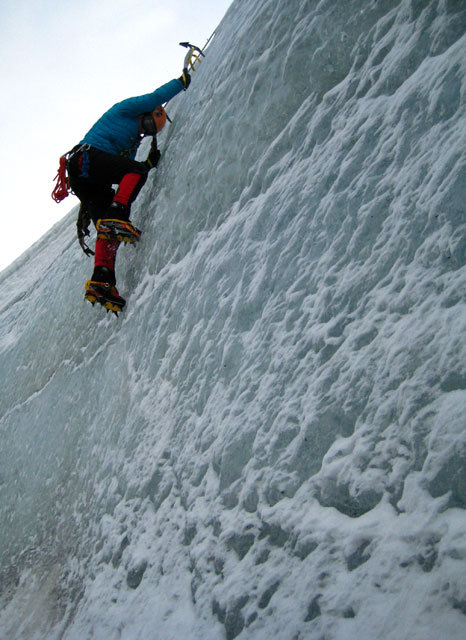
Photo Credit: Christina Hammock
A member of the Palmer Station glacier search and rescue team trains on ice face.
Recreation opportunities have been limited this month, due to very short days and unpredictable weather, with 70-knot winds on a recent Sunday. But every opportunity available has been taken, with trips to nearby islands when wind speeds are below 25 knots, and trips up the glacier when they are not. Several people on station participated in The Ride of Silence As the winter weather sets in and temperatures continue to drop, creaks and groans become less common from the glacier behind the station. The thunderous calving events are even rarer. Cloud cover has created some spectacular sunrises and sunsets, providing amazing shades of pinks and oranges that can never be properly captured by a photograph. Rare breaks in the cloud cover have also provided some great stargazing. Palmer Station plunges into winter seasonPosted May 6, 2011
April at Palmer Station The first half of April barely slackened from the pace set in the first week. While the ship took away most of the Palmer Long Term Ecological Research There was also a new science team in town — a group that became affectionately known as “the badgers.” 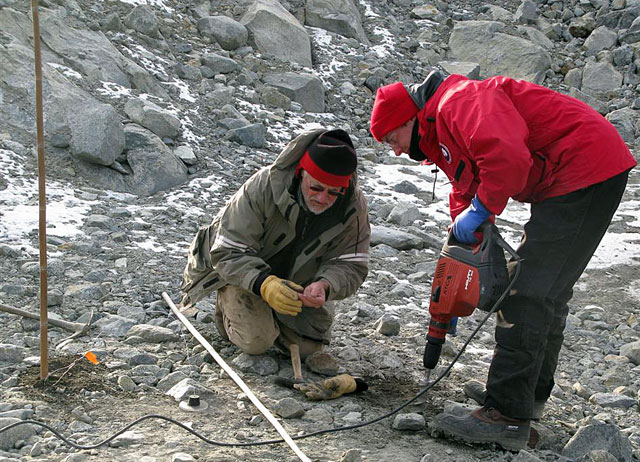
Photo Credit: Kelly Wilhelm
Scientists Adam Beilke, left, and James Bockheim collect soil samples for a study on permafrost and climate change.
Named partly after the mascot of their home institution, the University of Wisconsin-Madison Armed with drills, picks, and rucksacks, the group looked much like an Indiana Jones expedition as they set out from station to collect soil samples and set up remote instrumentation on many of the local islands. One of the many interesting aspects of their research is how the ripple effects of climate change play out in the Antarctic, as the glacier melt exposes land rather than sea, as it does in the Arctic. Landscape changes of a much more rapid kind were also taking place in early April, as the antenna riggers once again altered the Palmer skyline. After days of up-and-down climbing, a 100-foot-tall relic of communication days gone by was dismantled and transported to station piece by piece in a Zodiac. The tower formerly held an HF antenna that was installed in 1972 for direct communication with other U.S. Antarctic Program (USAP) Meanwhile, the station hosted a few special visitors. The first was a representative from the Point Sur, a 135-foot-long research vessel based in California, who was on station to learn and plan for possible USAP summer science cruises based from Palmer. The scientific community welcomed the opportunities that a smaller vessel could provide, and station staff took a keen interest in the novel possibility. In addition, a couple of representatives from the National Science Foundation On April 21, the Gould arrived at station carrying a research team led by Kristin O’Brien But before the ship can dock after these fishing cruises, the water flow to the Gould’s on-board fish tanks must be shut down, making the task of transporting the icefish to the Palmer aquarium a race against time to keep the fish alive. Palmer’s logistics team proved up to the task by coordinating what O’Brien said was the smoothest offload she had ever seen. Recreation was in full stride for the new season. The first weekend of winter offered the perfect chance for new Palmer crewmembers to get to know each other with an a night of karaoke. Not only did folks let loose their voices, but also several surprise guests appeared in costumes that only a rummage through the skua bin could supply. One weekend, the badgers led a geology walk for station members that highlighted the various land formations on the local islands. A rare afternoon of blue skies and calm winds was occasion for a full round of disc golf on the course in Palmer’s “backyard.” Earth Day was commemorated at Palmer with two special events. The first was participation in the Nature Conservancy’s Picnic for the Planet, with a picnic on the water in a Zodiac, complete with red-checkered tablecloth and accordion accompaniment. The other was the traditional underwater daisy picking, where the science divers remove litter from the waters around the pier and volunteers help to haul up relics, ranging from old soda bottles to long-missing tools. April started with a splash, and we expect the winter season will go along swimmingly. Emperor penguin makes rare appearance at Palmer StationPosted April 22, 2011
Standing tall and surveying the landscape, he almost seemed to know how rare he was. Or, maybe, how lost. An emperor penguin took up residence at Palmer Station A steady stream of onlookers walked out to the station’s “backyard” for a close peek at the emperor, which stood out so distinctly from the smaller penguins regularly seen at Palmer. Some long-timers could scarcely recall if one had ever been spotted here before. The beginning of March also brought rarities of a different kind of wildlife — one that lived about 70 million years ago. A paleontology team, led by Peter Ward and Joseph Kirschvink Back near the Palmer Station waters, records were also being broken. A science dive team, led by Chuck Amsler, Bill Baker and Jim McClintock The Palmer Long Term Ecological Research But March at Palmer wasn’t all left-brain. Two impressive artistic events brought a note of aesthetics and entertainment to station. The first was a visual art show with entries ranging from ice carvings and hand-made instruments to paintings, sculptures, and weavings. The following weekend brought an intimate Open Mic night, complete with acoustic guitar solos, accordion duos, storytelling, rapping, and a full-band set. Costumes, inside jokes, and re-written lyrics with a Palmer twist highlighted just how familial a community can be by the end of a great season. Inevitably, outdoor recreation inspired by great weather and end-of-season excitement partially gave way to the drum of station turnover preparation. Boxes and luggage were filled meticulously with samples and chemicals, travel gear and guidebooks. The collective keyboard strokes of “End of Season Reports” being typed could be heard around station. Meanwhile, a legacy was being fabricated behind closed doors. After weeks of work, investing many hours of free time, a team of station craftsmen unveiled a new and exquisite back bar, installed just in time for the arrival of the Gould and the winter crew. When station personnel turnover hit, not a minute was wasted, as Palmer seemed to hum like a well-oiled machine. Even a partial list of the week’s schedule would have been a feat to accomplish in seven days: station fuel transfer; turnover of Fire, Glacier Search and Rescue, Ocean Search and Rescue, and Trauma teams; a fire drill walk-through; moving several milvans of cargo; food offload; boating courses; orientations; cross-town dinners; ship line handler training; and spill response exercises. In addition, a team of 15 volunteers joined antenna riggers at the top of the glacier behind the station to hoist a new kind of tower for the very low frequency (VLF) project antenna. When it was all over, there was an unmistakable mixture of exhaustion and excitement on both the Gould and at the pier, as the ship pulled away and the first day of winter began. Ushering in a March for the record books, the emperor penguin turned out to be only one of many firsts to be marked at Palmer in the finale of summer. Palmer Station personnel construct new boat rampPosted March 11, 2011
The beginning of February at Palmer Station The LTER cruise proved successful, with good weather for water sampling and installing temporary field camps for seabird census work on islands to the south. The LTER project, nearly 20 years old, studies the effects of climate change on the marine ecosystem along the northwestern region of the Antarctic Peninsula. The Gould visited Palmer Station again briefly on its way back north to take with it members of several science teams that had been working around the nearby islands on projects ranging from bugs to microbes to underwater gliders. During the lull in science support activity, the station crew completed a long-awaited project: The boathouse now has a large deck platform with room for several boats, replacing the small ramp that formerly fit only one. This will prevent the need to pile boats all over the pier and the road when inclement weather requires them to be out of the water. Late in February, the Gould returned, bringing a science dive team from the University of Alabama at Birmingham and University of South Florida Three science groups remained on board the Gould to do geological work in the James Ross Island vicinity, the northernmost reaches of the Antarctic Peninsula. David Barbeau Before South America and Antarctica pulled apart, a land bridge existed between the continents. Ross MacPhee 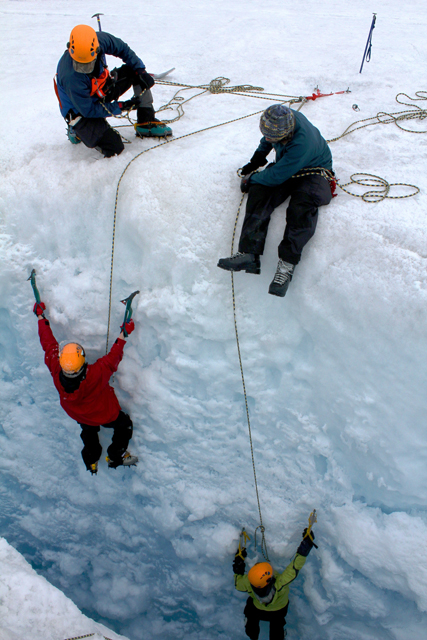
Photo Credit: Tim Nicoll
Palmer Station Glacier Search and Rescue team members belay scientists Kim Bernard and Kate Ruck into a crevasse during a recreation day.
Joseph Kirschvink So far, the teams have reported some interesting findings. In a recent report, Peter Ward Back at Palmer Station, a rare calm Sunday provided a chance for the Glacier Search and Rescue team to host a recreation day. Interested parties were taken to a section of glacier overhanging Arthur Harbor and lowered into a crevasse. They then had the opportunity to climb back out on the ice face. Nearly half the station participated, both scientists and station support staff alike. In contrast to January’s beautiful sunny calm, February was a month of dreary drizzle. The final week brought in a barrage of significant low-pressure systems, pummeling the station with wind and ocean swells for days on end. Autumn seems to be upon us. Summer science hits high mark at Palmer StationPosted February 4, 2011
The weather at Palmer Station The weather arrived serendipitously, as the station simultaneously reached its maximum number of science groups for the season, and nearly its personnel capacity. Of the new arrivals this month, Richard Lee and David Denlinger’s 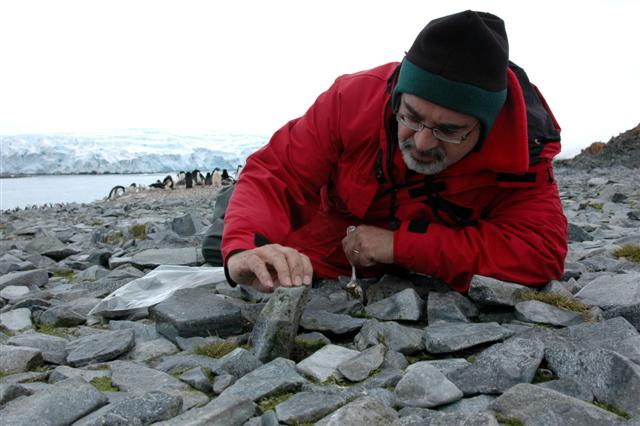
Photo Credit: Peter Rejcek/Antarctic Photo Library
David Denlinger searches for Belgica antarctica on Torgerson Island off the Antarctic Peninsula during the 2009-10 field season.
Differing from last season, two members of the group will stay through the end of April to collect the tiny insects as they slowly freeze in preparation for the winter season. This extra time will provide information concerning the coping mechanisms these flightless flies use to survive the Antarctic winter. A new research group, led by Matthew Cottrell from the University of Delaware These microbes, called photoheterotrophs, are able to grow both by absorbing light energy and by consuming other organic materials. Because light levels differ so drastically here from summer to winter, Cottrell is interested in the seasonal habits of these microbes. One of the busier research cruises of the season aboard the Laurence M. Gould The scientific aspect of the trip was successful. And so was the recreational aspect. Traditionally, during the PAL LTER cruise, the Gould visits Rothera, the British Antarctic Survey’s But this year the scientists and crew of the Gould defeated the British, 1-0. Some attribute their good luck to the braying of a vuvuzela on the American side, brought directly from the 2010 World Cup by South African Kim Bernard, a krill researcher on the PAL LTER. Back on station, recreational activity has been pervasive in the off-hours. The long spell of miserable weather in October and November definitely set a tone for the season that has everyone taking full advantage of any nice day. Scheduled evening events occurring indoors, like science lectures, have had a tendency to go on hold this month, as people rush out to pursue outdoor activities. Even the wildlife seems to be more abundant, as crabeater seals laze on ice floes by the dozen and humpback whales make appearances within the boating limits. The warm sun has also increased calving activity on the local glacier above Arthur Harbor. But those wishing to go hiking on the glacier this month have had to employ increased awareness, as snowmelt reveals new cracks and crevasses. The station’s Glacier Search and Rescue team (GSAR) had to decrease the safe recreational area, as several encroaching crevasses have widened enough to gulp up a person, and new cracks within the flagged area are enough to grab an ankle, or a knee and thigh in some spots. Fortunately, GSAR’s proactive work has prevented any injuries. And, on the plus side, a new tongue of recreation area was opened on the back side of the glacier, allowing Palmer residents to travel by foot to the near edge of a point overlooking Biscoe Bay. Small community at Palmer shifts with the arrival of shipsPosted January 7, 2011
The nuances of station life change subtly with every shift in personnel. The feel of December was heavily influenced by the distinct influx of voice recorders and scribbling notebooks held by science-journalism fellows from the Marine Biological Laboratory Led by Chris Neill, a journalism group visits Palmer Station In addition to these wielders of the mighty pen, our very own poet (they do exist), Katharine Coles joined us on an Antarctic Artists and Writers Program She said, “This has been, for me, an absolutely magical and life-changing experience. And for me it’s not just because of the icebergs and the penguins, although the icebergs and the penguins are quite wonderful. The thing that has been most surprising to me, and that has given me the most food for thought … has been the community and the people here. … The way that you use language and play with language at this station is something that is a delight to a poet and is something that I absolutely would be unable to ignore.” The science community at Palmer Station has banded together on a joint project this month. The Palmer Long Term Ecological Research (PAL LTER) The scientists collected a large amount of seawater and separated it into three groups that simulate different concentrations of CO2: pre-Industrial Revolution CO2 levels (180 parts per million), current CO2 levels (390 ppm), and future peak CO2 levels projected by the United Nations Intergovernmental Panel on Climate Change The scientists hope to observe any changes occurring to the marine ecosystem based on these CO2 levels. They plan to perform this experiment again later in the season, and on the research vessel Laurence M. Gould The phytoplankton arm of the PAL LTER program launched an autonomous underwater vehicle this month. The AUV, or glider, “flew” to the Gerlache Strait and back, collecting water column information. Simultaneously, two other gliders were soaring through Antarctic waters; one in the Ross Sea north of McMurdo Station Our holiday season was kicked off with a philanthropic visit from the Abercrombie & Kent cruise liner Le Boreal. The guests on this cruise choose to pay a little extra in order to bolster the scientific community here. This year they donated a digital microscope camera to the LTER group. 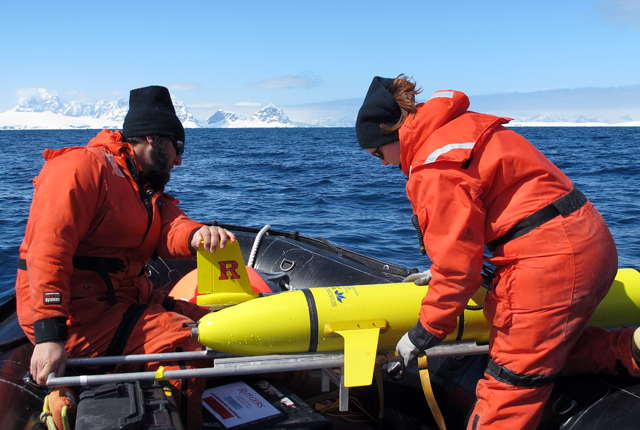
Photo Credit: Jennifer Bogo
Michael Garzio and Kaycee Coleman launch a glider near Palmer Station. The autonomous underwater vehicle takes physical ocean measurements.
This program is supported and encouraged by Jim McClintock We were also visited this month by the Russian icebreaker Kapitan Khlebnikov, and with it, Dr. Joanne Feldman, who served as the Palmer Station doctor last summer season. The Kapitan Khlebnikov sailed a semi-circumnavigation of the Antarctic continent after leaving Palmer Station, and Dr. Jo was able to hand carry several postcards from Palmer to McMurdo, just in time for the holiday. [See previous article: Diving into medicine.] Our holiday season has been festive and busy. We sat down to a wonderful Christmas dinner with a table set for 33, our current population. The following day held Palmer’s traditional “Yankee swap” gift exchange, where rules were argued lovingly and gifts were stolen respectfully. Our holiday din: Adélie chicks peeping, gentoos porpoising, humpbacks exhaling, and elephant seals making that awful sound that elephant seals make. |
Home /
Around the Continent /
Palmer Station Archives - 2011
"News about the USAP, the Ice, and the People"



For USAP Participants |
For The Public |
For Researchers and EducatorsContact UsU.S. National Science FoundationOffice of Polar Programs Geosciences Directorate 2415 Eisenhower Avenue, Suite W7100 Alexandria, VA 22314 Sign up for the NSF Office of Polar Programs newsletter and events. Feedback Form |

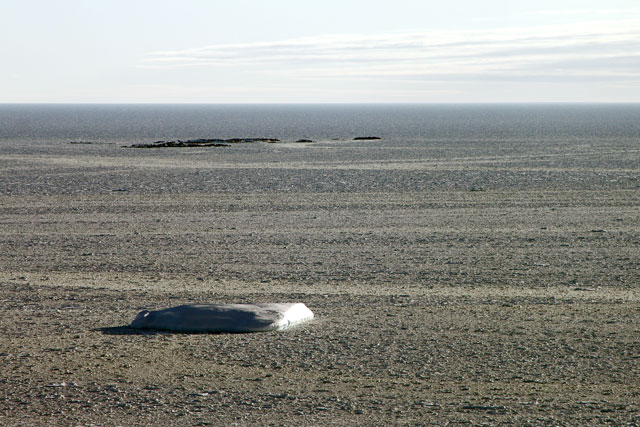
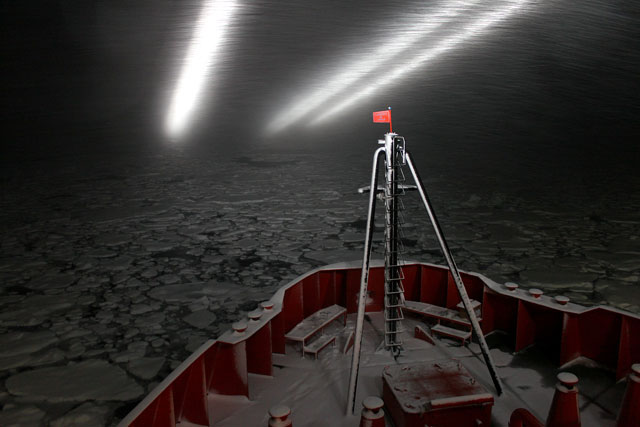
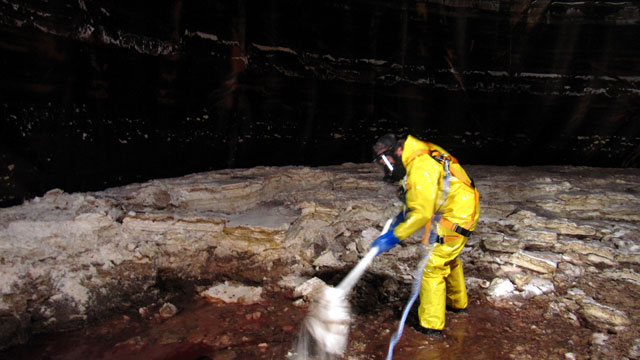
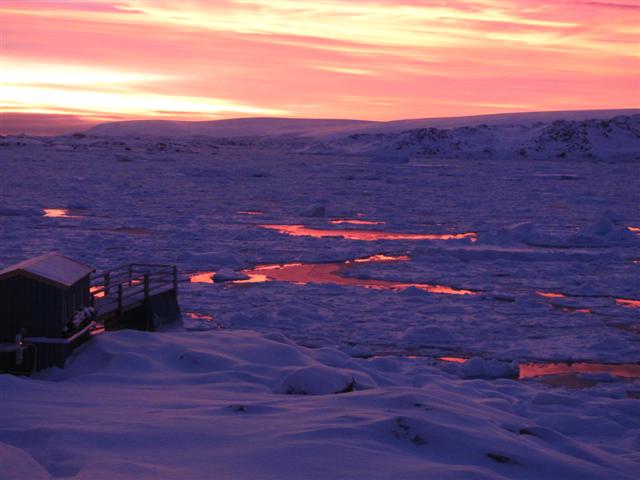
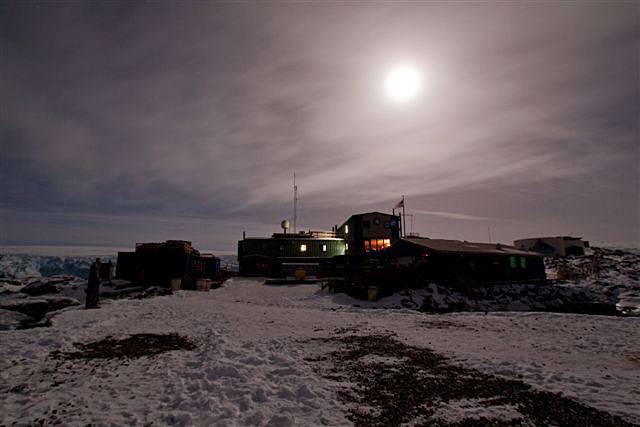
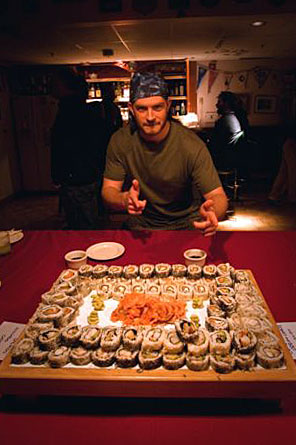
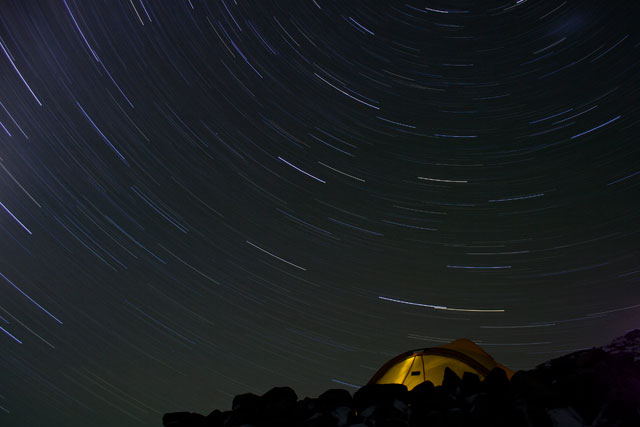
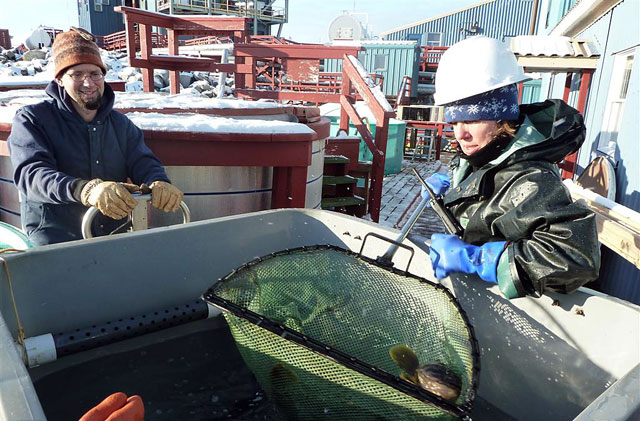
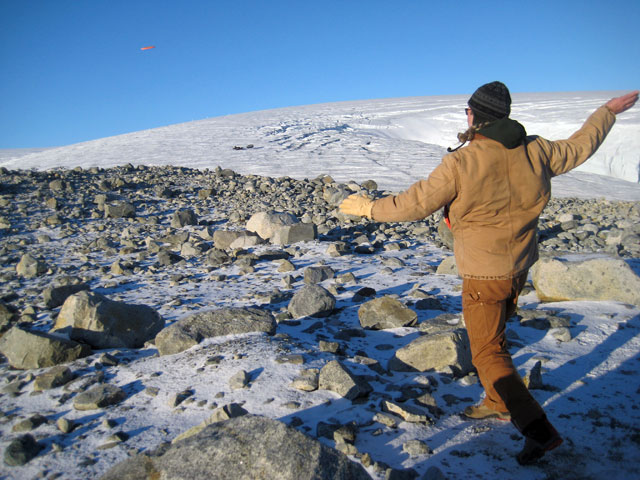
.jpg)
